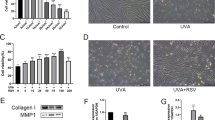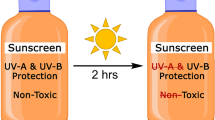Abstract
The present study illustrates the photosensitizing behavior of mefloquine (MQ) in human skin keratinocytes under ambient doses of UVB and sunlight exposure. Photochemically, MQ generated reactive oxygen species superoxide radical, hydroxyl radical, and singlet oxygen through type I and type II photodynamic reactions, respectively, which caused photooxidative damage to DNA and formed localized DNA lesions cyclobutane pyrimidine dimers. Photosensitized MQ reduced the viability of keratinocytes to 25 %. Significant level of intracellular reactive oxygen species (ROS) generation was estimated through fluorescence probe DCF-H2. Increased apoptotic cells were evident through AO/EB staining and phosphatidyl serine translocation in cell membrane. Single-stranded DNA damage was marked through single-cell gel electrophoresis. Mitochondrial membrane depolarization and lysosomal destabilization were evident. Upregulation of Bax and p21 and downregulation of Bcl-2 genes and corresponding protein levels supported apoptotic cell death of keratinocyte cells. Cyclobutane pyrimidine dimers (CPDs) were confirmed through immunofluorescence. In addition, hallmarks of apoptosis and G2/M phase cell cycle arrest were confirmed through flow cytometry analysis. Our findings suggest that MQ may damage DNA and produce DNA lesions which may induce differential biological responses in the skin on brief exposure to UVB and sunlight.

Mefloquine is photosensitized by UVB and sunlight exposure at an appropriate dose and generates ROS involving both type I and type II photosensitization mechanisms. These ROS primarily damage DNA, cell membrane, and membrane-bound organelles. MQ differentially affects various biological processes which end into apoptosis of the cell








Similar content being viewed by others
References
Ali D, Verma A, Mujtaba SF, Dwivedi A, Hans RK, Ray RS. UV-B induced apoptosis and DNA damaging potential of chrysene via reactive oxygen species in human keratinocytes. Toxicol Lett. 2011;204:199–207.
Aloisi GG, Barbafina A, Canton M, Acqua FD, Elisei F, Facciolo L, et al. Photophysical and photobiological behavior of antimalarial drugs in aqueous solutions. Photochem Photobiol. 2004;79(3):248–58.
Aloisi GG, Amelia M, Barbafina A, Latterini L, Elisei F, Acqua FD, et al. Photochem Photobiol. 2007;83(3):664–74.
Armstrong BK, Kricker A. The epidemiology of UV induced skin cancer. Photochem Photobiol B. 2001;63:8–18.
Boya P, Gonzalez-Polo R, Poncet D, Andreau K, Vieira HL, Roumier T, et al. Mitochondrial membrane permeabilization is a critical step of lysosome-initiated apoptosis induced by hydroxychloroquine. Oncogene. 2003;22:3927–36.
Brickelmaier M, Lugovskoy A, Kartikeyan R, Reviriego-Mendoza MM, Allaire N, Simon K, et al. Identification and characterization of mefloquine efficacy against JC virus in vitro. Antimicrob Agents Chemother. 2009;53(5):1840–9.
Bruls WA, Weelden HV, van der Leun JC. Transmission of UV-radiation through human epidermal layers as a factor influencing the minimal erythema dose. Photochem Photobiol. 1984;39:63–7.
Cadet J, Mouret S, Ravanat JL, Douki T. Photoinduced damage to cellular DNA: direct and photosensitized reactions. Photochem Photobiol. 2012;88(5):1048–65.
Chen MK, Tsai YC, Li PY, Liau CC, Taniga ES, Chang DW, et al. Delay of gap filling during nucleotide excision repair by base excision repair: the concept of competition exemplified by the effect of propolis. Toxicol Sci. 2011;122(2):339–48.
Chignell CF, Sik RH. A photochemical study of cells loaded with 2′, 7′-dichlorofluorescin: implications for the detection of reactive oxygen species generated during UVA irradiation. Free Radic Biol Med. 2003;34(8):1029–34.
Davids LM, Kleemann B. The menace of melanoma: a photodynamic approach to adjunctive cancer therapy. In: Duc, G. H. T., eds. Melanoma—from early detection to treatment. In tech; 2013: 583-628.
Gofton TE, Al-Khotani A, O’Farrell B, Ang LC, McLachlan RS. Mefloquine in the treatment of progressive multifocal leukoencephalopathy. J Neurol Neurosurg Psychiatry. 2011;82(4):452–5.
Guicciardi ME, Leist M, Gores GJ. Lysosomes in cell death. Oncogene. 2004;23:2881–90.
Haywood R, Andrady C, Kassouf N, Sheppard N. Intensity-dependent direct solar radiation and UVA-induced radical damage to human skin and DNA, lipids and proteins. Photochem Photobiol. 2011;87:117–30.
Henery S, George T, Hall B, Basiji D, William O, Morrissey P. Quantitative image based apoptotic index measurement using multispectral imaging flow cytometry: a comparison with standard photometric methods. Apoptosis. 2008;13:1054–63.
Hsin-Lung L, Satoshi N, Lisa M, Barbara W, Akira Y, Douglas WE, et al. Differential biologic effects of CPD and 6-4PP UV-induced DNA damage on the induction of apoptosis and cell-cycle arrest. BMC Cancer. 2005;5:135.
Johansson A, Appelqvist H, Nilsson C, Kagedal K, Roberg K, Ollinger K. Regulation of apoptosis-associated lysosomal membrane Permeabilization. Apoptosis. 2010;15:527–40.
Kaufmann AM, Krise JP. Lysosomal sequestration of amine-containing drugs: analysis and therapeutic implications. J Pharm Sci. 2007;96:729–46.
Kristensen S, Orsteen A, Sande SA, Tønnesen HH. Photoreactivity of biologically active compounds VII. Interaction of antimalarial drugs with melanin in vitro as part of phototoxicity screening. Photochem Photobiol. 1994;26(1):87–95.
Ling YH, Liebes L, Zou Y, Perez-Soler R. Reactive oxygen species generation and mitochondrial dysfunction in the apoptotic response to Bortezomib, a novel proteasome inhibitor, in human H460 non-small cell lung cancer cells. J Biol Chem. 2003;278:33714–23.
Livak KJ, Schmittgen TD. Analysis of relative gene expression data using real time quantitative PCR and the (2ΔΔCT) method. Methods. 2001;25:402–8.
Mujtaba SF, Dwivedi A, Yadav N, Ray RS, Singh G. Singlet oxygen mediated apoptosis by Anthrone involving lysosomes and mitochondria at ambient UV- radiation. Hazard Mater. 2013;252–253:258–71.
Nys K, Agostinis P. Bcl-2 family members: essential players in skin cancer. Cancer Lett. 2012;320(1):1–1.
Oliveira CS, Turchiello R, Kowaltowski AJ, Indig GL, Baptista MS. Major determinants of photoinduced cell death: subcellular localization versus photosensitization efficiency. Free Radic Biol Med. 2011;51:824–33.
Paris C, Bertoglio J, Bréard J. Lysosomal and mitochondrial pathways in miltefosine-induced apoptosis in U937 cells. Apoptosis. 2007;12:1257–67.
Petersen AB, Gniadecki R, Vicanova J, Thorn T, Wulf HC. Hydrogen peroxide is responsible for UVA-induced DNA damage measured by alkaline comet assay in HaCaT keratinocytes. Photochem Photobiol B Biol. 2000;59(1–3):123–31.
Petrocelli T, Slingerland J. UVB induced cell cycle checkpoints in an early stage human melanoma line, WM35. Oncogene. 2000;19:4480–90.
Ravanat J, Mascio PD, Martinez GR, Medeiros MHG, Cadet J. Singlet oxygen induces oxidation of cellular DNA. J Biol Chem. 2000;275(51):40601–4.
Redmond RW, Kochevar IE. Spatially-resolved cellular responses to singlet oxygen. Photochem Photobiol. 2006;82:1178–86.
Repnika U, Boris T. Lysosomal–mitochondrial cross-talk during cell death. Mitochondrion. 2010;10(6):662–9.
Ryter SW, Tyrrell RM. Singlet molecular oxygen (1O2): a possible effector of eukaryotic gene expression. Free Radic Biol Med. 1998;24(9):1520–34.
Sheen J, Zoncu R, Kim D, Sabatini DM. Defective regulation of autophagy upon leucine deprivation reveals a targetable liability of human melanoma cells in vitro and in vivo. Cancer Cell. 2011;19:613–28.
Shoham A, Hadziahmetovic M, Dunaief JL, Mydlarski MB, Schipper HM. Oxidative stress in diseases of the human cornea. Free Radic Biol Med. 2008;45:1047–55.
Suen D, Norris KL, Youle RJ. Mitochondrial dynamics and apoptosis. Genes Dev. 2008;22:1577–90.
Valencia A, Kochevar IE. Ultraviolet A induces apoptosis via reactive oxygen species in a model for Smith–Lemli–Opitz syndrome. Free Radic Biol Med. 2006;40:641–50.
Wischermann K, Popp S, Moshir S, Scharfetter-Kochanek K, Wlaschek M, de Gruijl F, et al. UVA radiation causes DNA strand breaks, chromosomal aberrations and tumorigenic transformation in HaCaT skin keratinocytes. Oncogene. 2008;27:4269–80.
Xue L, Chiu S, Oleinick NL. Photochemical destruction of the Bcl-2 oncoprotein during photodynamic therapy with the phthalocyanine photosensitizer Pc 4. Oncogene. 2001;20:3420–7.
Yadav N, Dwivedi A, Mujtaba SF, Kushwaha HN, Singh SK, Ray RS. Ambient UVA-induced expression of p53 and apoptosis in human skin melanoma A375 cell line by Quinine. Photochem Photobiol. 2013;89:655–64.
Yao J, Zhang G. Lysosomal destabilization via increased potassium ion permeability following photodamage. Biochim Biophys Acta. 1997;1323:334–42.
Acknowledgments
The authors wish to thank the Director CSIR-IITR for his valuable support in this study.
Funding
This work is supported by University Grants Commission (UGC) and CSIR network project, UNDO (BSC 0103), New Delhi, India.
Conflict of interest
The authors declare that there are no conflicts of interest.
Author information
Authors and Affiliations
Corresponding author
Rights and permissions
About this article
Cite this article
Yadav, N., Dwivedi, A., Mujtaba, S.F. et al. Photosensitized mefloquine induces ROS-mediated DNA damage and apoptosis in keratinocytes under ambient UVB and sunlight exposure. Cell Biol Toxicol 30, 253–268 (2014). https://doi.org/10.1007/s10565-014-9280-7
Received:
Accepted:
Published:
Issue Date:
DOI: https://doi.org/10.1007/s10565-014-9280-7




